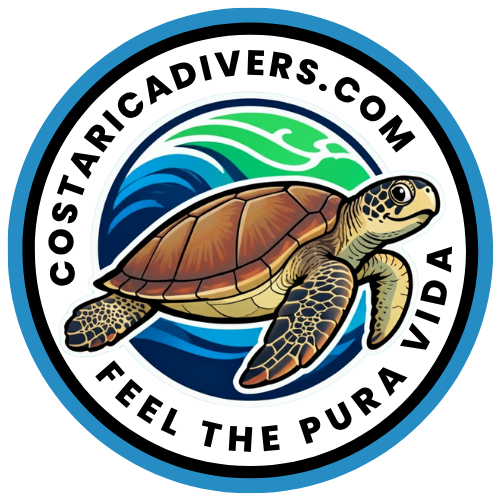Have you ever wondered what it’s like to float effortlessly on crystal-clear water, gazing down at colorful fish swimming just below you? That’s the magic of snorkeling, and I’m here to tell you that it’s one of the most accessible ways to explore the underwater world.
As a diving instructor in Costa Rica, I’ve taught hundreds of students their first snorkeling techniques. I’ve seen complete beginners transform from nervous first-timers to confident snorkelers gliding peacefully over coral reefs. The best part? Most of them were surprised by how easy and natural it felt once they understood the basics.
In this guide, I’ll walk you through everything you need to know about snorkeling for beginners. You’ll learn what equipment you need, how to breathe properly, essential safety tips, and how to avoid common mistakes. By the end, you’ll feel ready to discover an entirely new world beneath the surface.
Snorkeling is swimming on the water’s surface while wearing a mask that lets you see underwater and breathing through a snorkel tube. It’s that simple. You don’t need any special certification or years of training.
What makes snorkeling perfect for beginners is its simplicity. Unlike scuba diving, you stay at the surface. You don’t need heavy equipment or extensive training. Within minutes of entering the water, you might see tropical fish, sea turtles, rays, and vibrant coral formations.
Snorkeling keeps you on the surface where you breathe normal air through a tube. Scuba diving takes you deep underwater with compressed air tanks. Snorkeling requires minimal equipment and no certification, while scuba diving needs extensive training and PADI certification.
For beginners, snorkeling is the perfect introduction. It’s more affordable, less intimidating, and you can start immediately. Many of my diving students actually began as snorkelers who wanted to explore deeper.
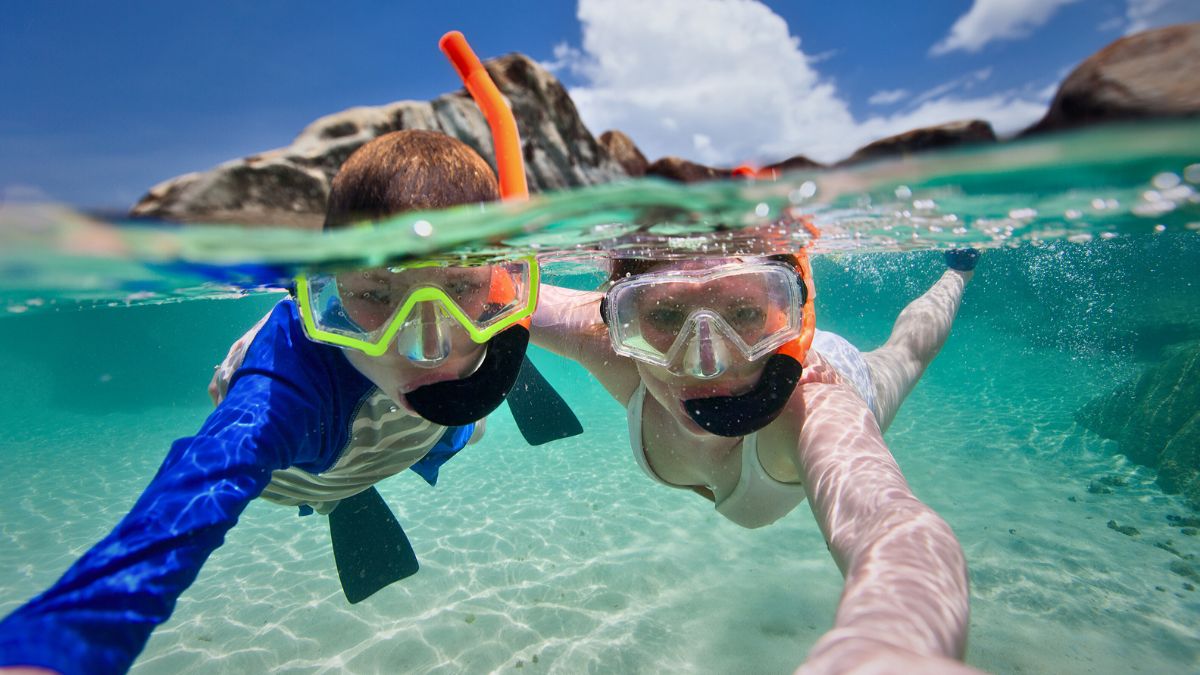
Basic swimming skills definitely help, but they’re not absolutely required for snorkeling. Saltwater is more buoyant than pool water, which means you naturally float more easily. Add a snorkeling vest or flotation device, and even non-swimmers can enjoy the experience safely.
I recently worked with a student named Maria who couldn’t swim at all. We started in waist-deep water with a flotation vest. Within twenty minutes, she was comfortably floating and watching fish swim beneath her. By the end of the session, she had tears of joy in her eyes.
That said, I always recommend building basic water confidence before your snorkeling adventure. If you’re nervous about water, practice floating in a pool first.
Did you know? Costa Rica has over 800 miles of coastline on two different oceans, offering snorkeling opportunities year-round in warm, calm waters perfect for beginners.
You only need three basic pieces of equipment: a mask, a snorkel, and fins. Let me walk you through each one.
Your mask is your window to the underwater world. A poorly fitting mask will leak and fog constantly, ruining your experience.
Here’s how to test if a mask fits properly. Hold the mask against your face without using the strap. Breathe in gently through your nose. The mask should suction to your face and stay in place when you let go. If it falls off, try a different size.
Look for masks made with soft silicone skirts. Choose masks with tempered glass lenses rather than plastic for better clarity and safety.
One mistake I see constantly is beginners tightening their mask straps too much. The strap should be snug but not tight. The suction creates the seal, not the strap pressure. An overtightened mask causes headaches and actually leaks more.
I strongly recommend dry snorkels for anyone learning snorkeling. Traditional snorkels are just open tubes. If a wave splashes over you, water rushes straight into your mouth.
Dry snorkels have a special valve on top that automatically closes when water hits it. This prevents water from entering even if waves wash over you. Most dry snorkels also include a purge valve at the bottom that makes clearing any water incredibly easy.
The difference is huge for beginner confidence. I’ve had students panic with traditional snorkels because water kept flooding in. The same students relaxed completely once they switched to dry snorkels.

I always recommend fins for beginners. Fins dramatically reduce the energy you need to move through water. Without fins, you’ll tire quickly. With fins, gentle kicks propel you forward effortlessly.
Fins also provide safety. If you encounter an unexpected current or need to swim back to shore, fins give you the power to do so without exhausting yourself.
Full-foot fins slide onto your bare feet like shoes and work perfectly for warm-water snorkeling. When trying fins, they should fit snugly without pinching. Too loose and they’ll slip off. Too tight and you’ll get blisters.
A complete beginner snorkeling set costs around one hundred dollars. Renting typically costs fifteen to twenty-five dollars per day. If you’re only snorkeling once, renting makes financial sense.
However, buying your own equipment has major advantages. Your own mask will fit your face perfectly. You can practice before your trip. And rental equipment often lacks features like dry snorkels.
If you plan to snorkel more than three or four times, buying equipment pays for itself.
I always recommend starting from a beach rather than jumping off a boat into deep water. Beach entries let you wade in gradually. You can start in waist-deep water where you can stand up anytime.
Choose locations with calm, protected water. Bays and coves typically offer gentle conditions perfect for beginners. Morning hours usually provide the calmest water before afternoon winds pick up.
In Costa Rica, locations like Uvita and Manuel Antonio offer excellent beginner-friendly conditions with warm water year-round and abundant tropical fish in shallow, protected areas.
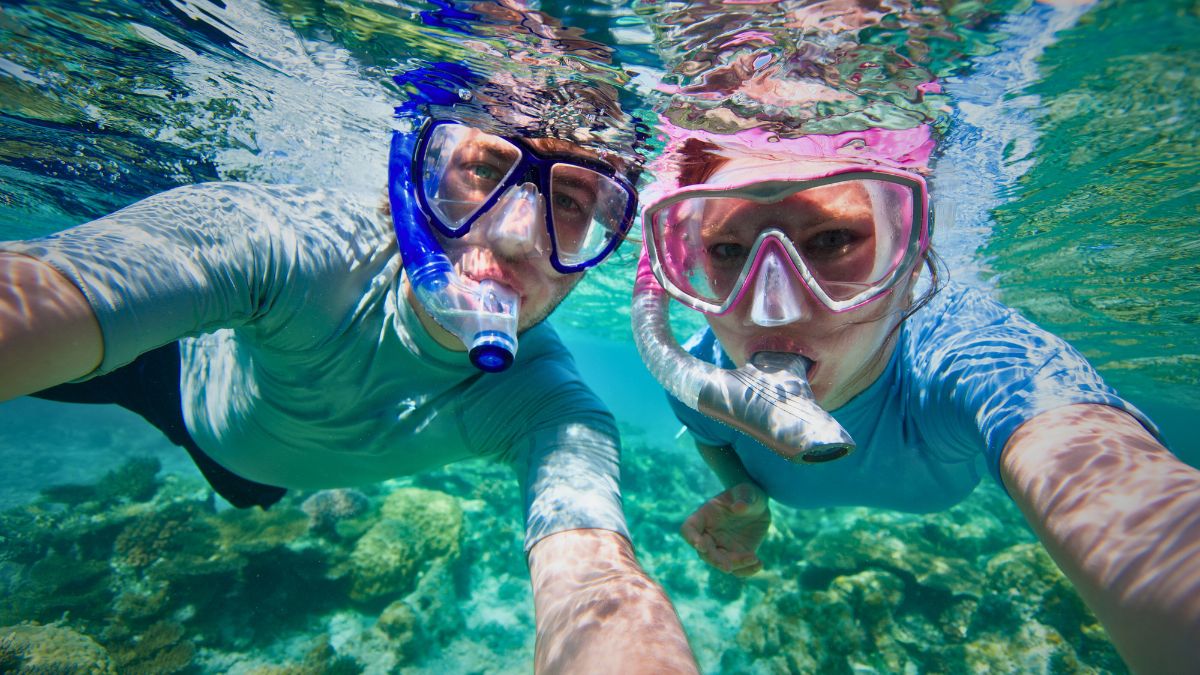
Mix a few drops of baby shampoo with water in a small spray bottle. Before snorkeling, spray the inside of your mask lens and rub it around gently. Rinse briefly with water, but leave a thin film on the lens.
This prevents water condensation from forming fog. Apply your anti-fog treatment right before entering the water for best results.
Start practicing on land before you touch water. Put your mask and snorkel on while sitting on the beach. Breathe slowly and deeply through your mouth only. Keep your nose breathing completely stopped.
Breathe slower than you normally would. Deep, calm breaths work best. Quick, shallow breathing makes you feel like you’re not getting enough air.
Once comfortable on land, practice in shallow water where you can stand. Wade in until you’re waist-deep. Put your face in the water while keeping your feet on the bottom. Breathe slowly through your snorkel for a minute or two.
The key is staying calm. If you feel panic rising, stop and stand up. Take a break and try again when ready.
Fun fact: The word “snorkel” comes from the German word “schnorchel,” which was originally a submarine breathing device used during World War II.
Wade into the water slowly until you’re waist to chest deep. Put your fins on after you’re already in ankle-deep water, not on dry sand. If you must put fins on before entering, walk backwards or sideways.
Put your mask on once you’re in the water. Adjust the strap comfortably. Put the snorkel mouthpiece in your mouth and bite gently on the tabs while sealing your lips around it.
Take a few breaths through the snorkel while standing. Make sure everything feels comfortable before you start floating.
The correct position is completely flat on the water’s surface, face down. Imagine lying face-down on a massage table. Your body should be horizontal with your face in the water and your snorkel tube pointing straight up.
Many beginners try to lift their heads, which causes legs to sink and creates panic. Keep your head down. Trust your snorkel to bring air. Look down at the bottom, not forward.
Let the saltwater hold you up. If you relax completely, you’ll float effortlessly. Tension causes sinking. Your arms should stay relaxed at your sides or folded across your chest.
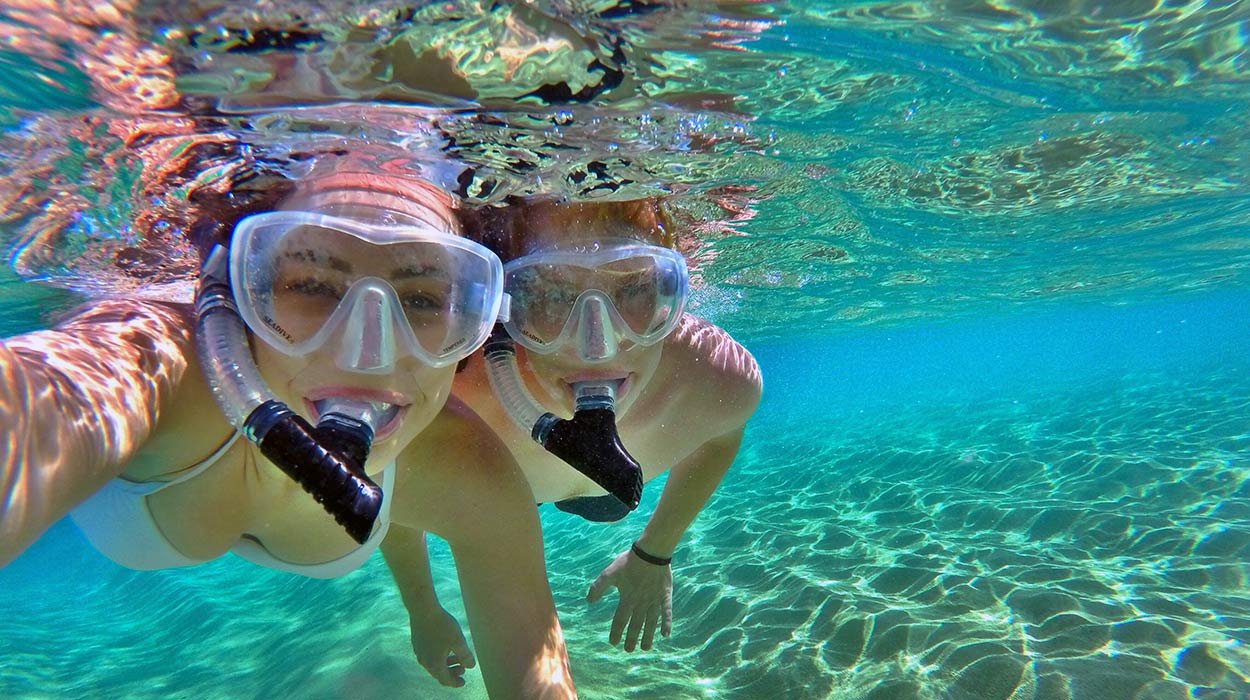
Breathe slowly and deeply through your mouth only. Inhale for three to four seconds, exhale for three to four seconds. This slow rhythm keeps you calm.
Never hold your breath while snorkeling. Continuous breathing is essential.
If water enters your snorkel, don’t panic. If your snorkel has a purge valve, simply blow out forcefully. Or surface and tilt your head back, then blow hard to blast water out the top.
Use slow, steady fin kicks. Your legs should move from the hip, not the knee. Keep your fins underwater throughout the entire kick. Kicking above the surface creates splashing and wastes energy.
Keep your arms still and relaxed. Let your fins do all the work. Move slowly through the water. Snorkeling isn’t a race. Slow movement lets you observe more marine life and reduces fatigue.
Always snorkel with a buddy. Your buddy watches for problems you might not notice. If you get tired, cramped, or disoriented, your buddy can help.
Before entering water, establish simple signals. Thumbs up means everything is okay. Waving arms means I need help. Stay close enough that you could reach your buddy quickly if needed.
Only snorkel on calm water days. If you see whitecaps, large waves, or rough conditions, skip snorkeling that day. Rough water makes everything harder and more dangerous.
Avoid areas with strong currents. Morning hours typically offer the calmest conditions. Wind usually picks up in the afternoon, creating waves.
In Costa Rica, the dry season from December through April generally provides the best snorkeling conditions.

Your back, neck, and legs point directly at the sun while you float face-down. You can get severely sunburned in thirty minutes without protection.
Wear a rashguard or thin wetsuit. These block UV rays completely. Apply reef-safe sunscreen to exposed skin. In Costa Rica, only reef-safe sunscreen is legally allowed in marine protected areas.
Apply sunscreen thirty minutes before entering water. Reapply every two hours.
I recommend flotation devices for most beginners. Snorkeling vests are inflatable vests worn over your torso. They let you rest floating effortlessly without swimming effort.
Flotation devices are especially valuable for non-swimmers or nervous beginners. They remove the fear of sinking and let you focus on enjoying underwater views.
The golden rule is simple: look but never touch.
Touching coral damages it. Coral looks like rock, but it’s actually living organisms. A single touch can kill coral that took decades to grow.
Never chase or touch fish. Some marine creatures are dangerous if touched. Certain fish have venomous spines. Some coral types cause painful stings.
Keep your hands folded across your chest to avoid accidental touching.
Rapid breathing triggers anxiety. Focus on slow, deliberate breathing. If panic rises, surface and breathe normally until calm.
Test all equipment thoroughly before entering water. If rental equipment doesn’t fit well, request different sizes.
Stay close to shore during first sessions. Swim parallel to the beach rather than straight out. Check your distance frequently.
Practice the clearing technique in shallow water. Use the purge valve or blast forcefully to expel water.
Maintain awareness of fin placement. Keep fins well above the bottom. Fold your arms to avoid reaching out.
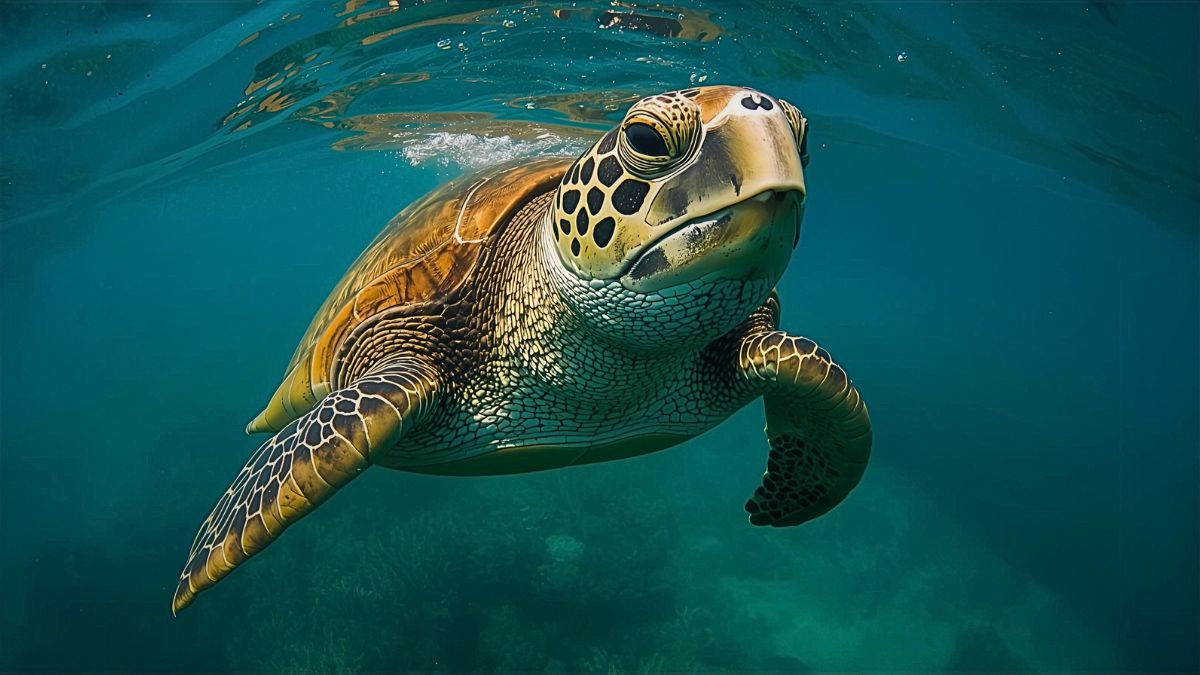
Costa Rica offers exceptional snorkeling with warm water year-round and protected areas perfect for learning. Water temperatures stay between twenty-six and twenty-nine degrees Celsius.
Uvita and Marino Ballena National Park offer calm protected waters and abundant marine life in shallow areas. Manuel Antonio National Park features beautiful beaches with easy snorkeling access. The Gulf of Papagayo provides consistently calm conditions ideal for learning.
Ready to explore Costa Rica’s best snorkeling destinations? Our local guides know every secret spot perfect for beginners.
Most beginners comfortably snorkel for thirty to sixty minutes before tiring. As you gain experience, you can extend sessions to several hours.
Tilt your head back slightly, press the top of the mask against your forehead, and exhale through your nose. The air pushes water out the bottom.
Proper technique makes snorkeling relaxing. Use slow fin kicks, maintain flat position, breathe slowly, and move at a leisurely pace.
Children as young as five or six can snorkel with proper supervision, appropriate equipment, and calm conditions. Flotation devices are highly recommended.
There’s no single best age. The determining factors are water comfort, ability to follow instructions, and physical fitness for swimming.
In warm tropical water like Costa Rica, a full wetsuit isn’t necessary for warmth. However, thin wetsuits or rashguards provide excellent sun protection.
Yes. Prescription snorkel masks are available, or you can wear contact lenses under a regular mask.
Snorkeling keeps you at the surface. You’re looking down at the bottom from above, which can range from one meter to twenty meters deep.
Yes, snorkeling is safe for beginners when you follow proper guidelines, use correct equipment, snorkel with a buddy, and choose appropriate conditions.
Beginner snorkeling typically occurs in areas where the water depth ranges from two to ten meters. You stay on the surface looking down.
Snorkeling for beginners opens a door to incredible underwater experiences. What seems intimidating at first becomes natural with proper guidance. I’ve watched countless students transform from nervous first-timers to confident snorkelers in a single afternoon.
The key is starting with the right equipment, following safety guidelines, and giving yourself permission to learn gradually. Costa Rica’s warm waters and protected areas provide the perfect environment for your first snorkeling experiences.
The ocean is waiting. Your adventure starts now.

Author: Peter Sawicki
Peter Sawicki is a PADI instructor with many years of experience and hundreds of certified students to his name. He is a technical diver, cave explorer, and climbing instructor with a background that spans both big wall expeditions and demanding technical ice climbs. Recognized multiple times with the prestigious PADI Elite Instructor Award, Peter combines deep professional knowledge with a passion for sharing the world of adventure, both underwater and above it.


